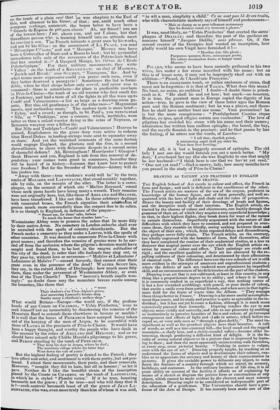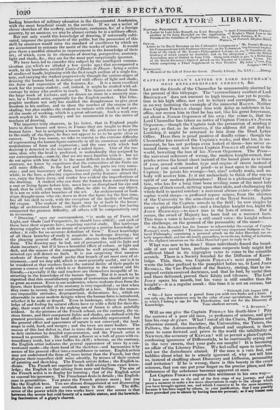DRAWING AS TAUGHT AND PRACTISED IN ENGLAND AND FRANCE.
THE English School of Art excels in colour and effect, the French in
and the deceptive truth of their interiors. The English artists, at- tracted by the charms of colour and chiaroscuro, run hastily through the grammar of their art, of which they acquire a very superficial knowledge; so that, in their highest flights, they break down for want of the menus to sustain themselves. Imperfectly acquainted with the nature of the difficulties with which they have to contend, and not prepared to over- come them, they stumble on blindly, seeing nothing between them and the object of their aim ; which, from repeated delays and discomfitures,. they perhaps never fully attain. The French artists, on the contrary, too wholly engrossed with the beauties of form, find themselves, after they have completed the routine of their academical studies, at a loss to discover that magical power over the eye which the English artists ex- ercise by means of colour and effect. Their paintings are crude and rigid ; and the excellent qualities of their art are obscured by the re- pelling coldness of their colouring, and deteriorated by their affectation of classical style. The difference between the two schools of art is still. more evident in the attempts of amateurs and unprofessional students; where the defects of each are rendered more prominent by. imperfect- ' skill, and an unconsciousness of his deficiencies on the part of the student. Drawing is an art that is not cultivated, at least in this country, in any thing like a proportionate degree to its utility; and where it is learnt, it is commonly studied in so superficial a way, that nothing comes of it but a few wretched scribblings with pencil, or poor daubs of colour, that excite a smile even from partial friends, and when seen in that legiti- mate field for the fruits of waste time the Album. "They manage these things better in France." Drawing is a far more useful accomplish- What would Britain—Europe—the world say, if the profane merit than music, and its study and practice is quite as agreeable to the
i
in- dividual; but t has not yet become a fashion, although it is much more bands of any Comte DE CHABROL, " Urbis Prmfectus," were to extensively pursued than formerly. Drawing teaches the eye to see objects more vividly and correctly, and adds to our pleasures by enabling us instinctively to perceive beauties of form and colour, of picturesque arrangement and effects of light and ...lade in nature, which before es- caped us, or were only seen as "through a glass darkly. The most in- those of LAURA in the precincts of Pere-la-Chaise. It would have significant as well as the grandest objects have their beauties. A tuft been a happy thought, and worthy the people who have dealt in of weeds, as well as a tree-crowned hill—the level mead and the rugged like manner by the relics of ABELARD and HELOISE ; and so we mountain—a shady lane, and a richly-wooded valley—become alike in- should have missed only Childe Harold's pilgrimage to his grave, teresting, though producing a different kind of delight,. It is the fa- ing to draw; and thus the most apparently uninteresting walk furnishes, at every step, some pictorial beauty. "Nothing in nature is vulgar, seen with the eye of art." Drawing properly taught, by teaching us to lea mg branches- of military education in the. Government Academies, with the most beneficial 'result to the service. If we see a berieg—of clever sketches of.the sceitery, architecture, costumes, of a foreign country,. by an. amateur, we maybe almost Certain he is a military officer. But not only would this knowledge-of drawing, if universally culti- vated, itnProVe thegeneral taste Of the public, but the possession of this skill by amateurs would raise the standard of excellence by which we are accustomed to estimate the merit of the works of artists. It would- give them a needful stimulus to improvement in the.knbwiedge of their art ; of which, eyen.in its elements of drawing, perspective, anatomy, light and shade,.&e. they are for the most part surprisingly ignorant. We have been.led to consider this subject by the intelligent commu- nication (to which we -alluded a few weeks ago) that accompanied a work, in stxIsumbers, entitled. Cour§ d'Etudes de Dessin ;- being a series of ,studies of heads, beginning with the first rough outline of a single fea- ture, and Carrying the student progressively through the variousstages of draWing the-human head, in outline and with effects of light and shade,. the form and expression of the -features, &c: It is a most excellent work forthe young student ; and, indeed, it might be studied with ad-
vantage by many who profess to teach. The figures are reduced from the large work • of LEMIRE, and are drawn on stone in a masterly man- ner, by a French artist, especially for the English market.' The litho- graphic 'medium not only has enabled the draughtsman to. give great freedcnii in his outline,, and . to glow the touches of the crayon in the shading,•but ,also. enables the itudent to imitatewith chalk or lead pen- cil the mode of working, which is a great advantage. Such a work was much needed in this country ; and we recommend it to the notice of teachers of drawing.
The iniporter truly observes, in his letter, that in England pupils learn to driMr, houses and trees, in France the' :ire taught to- draw the human form: but in assigning. a *reason for the preference to be given to the study 6f-the figure, he does not appear to us to be quite- clear or correct. The true reason, We take to consist in the extreme difficulty of representing the human figure correctly in all its numerous and subtle modulations- of form 'and expression ; and the ease with which bad draiving is detected in the insta-nce of a naked figure. One of the rea- sOns,'alscl, why the head is preferred, is undoubtedly: that assigned by oar correspondent,—namely, that we are most familiar with it : but we do not agree with him that it is the most difficult to.delineate ; on the - contrary, we know by experience that the extremities of the limbs are still more difficult. In the feet and hands, the parts are very.nume- rens ; and any inaccuracy .Of form, however alight, is -sbon detected ; while, in the thee, a pleasing expression and pretty feature attraet the eye, caw the fancy away, and render less evident the imperfections of the draWing; A student who can draw the human form correctly from a cast or living figure before him, must have so disciplined his eye and hand, that lie will, with very little effort, be able to draw any object. It is not so with other branches of the art. An architectural or land- sEasie:draughtsman, who sits down to draw the figure for the.first time, his 011 his Ain to seek, with the exception of the facility of handling tlie crayon. The *student of the figure may be at fault in the know- ledge of architectural forms, and the effects of landscape ; but having conquered the greateSt difficulty, all others will be comparatively easy tO overcome.
"-Dmiving," says our correspondent, " is made up of Form, and Light, arid Shade [and Perspective, he should have added]; and each of these have .their separate laws, requiring careful study. But landscape driwing supplies us with no means of acquiring a precise knowledge of either ; it calls for no accurate definition of form." Exact knowledge of all these branches of study is requisite in landscape drawing; but the pleasing 'general effects of nature obscure the imperfections of form; The 'drawing may be bad, out of perspective, and its light and shade incorrect ; but if it have a beautiful effect of colour, or light and dark, and the masses of the composition be well arranged, the unin- sitheted eye.will detect no fault. It is not surprising that amateur students of drawing should prefer that branch- of art most easy of at- titipment,—and we may add, which is most generally useful; nor is it to be Wondered at that teachers foster the natural desire of their pupils to pursue a course of study which is so flattering to the student and his friends,—cspecially if.the said teachers are themselves incapable of in- structing in the knowledge of the human figure. But it is much to be regretted that this unsatisfactory system of instruction should prevail to so great an extent. Even in our academies, where students draw from the figure, their knowledge of its anatomy is very superficial ; so that when they come to invent, they are continually at a loss. Hence the numer- ous impossible attitudes, disproportions, dislocations, &e., which are observable in most modern designs where the human form is introduced, whether it be nude or draped. Even in landscape, where their know- ledge of and feeling for natural effects have so wide a field for their dis- play, their want of skill in the making out of forms is often painfully evident.. In the pictures of the French school, on the contrary, the va- rious forms, and their component lights and shades, are defined with the greatest precision, and the loeal effects are admirably represented : but the general effect and appearanee of nature is not conveyed; the land- :Beane is cold, hard, and meagre ; and the trees are mere bushes. The reason of this last defect is, that in trees the forms are so numerous as to defy imitation by detailed representation, and the French artist is unused to generalize. He will paint a flower or a tuft of grass with ex-
traordinary truth, but a tree baffles his skill ; whereas on the contrary, the English artist indicates the general appearance Of trees by a con- -ventional mode—the short-hand of the sketcher—and harmonizes it by
Means of his general effect into a resemblance to nature. English artists may not understand the form of: trees better than the French, but they disguise their imperfect skill more adroitly, by means of thew system of painting and sketching. The French artists 'define ; the English in- ,dicate.' The French are superior in the skill arising from exact- know- -ledge; the English in that arising from taste Mid feeling. The aim of
the French artist is to display his learning ; that of the English artist to conceal his ignorance. The Frenchman deals in details ; the English- Man in generalities. You praise the French picture most ; but you like the English best. You are almost disappointed at not discovering faults in the one ; and you overlook many in the other. The diffe- rence of the power which the two works have over the senses is that between the severe but cold beauty of a marble statue, and the bewitch- ing fascination of a gipsy's charms.



























 Previous page
Previous page